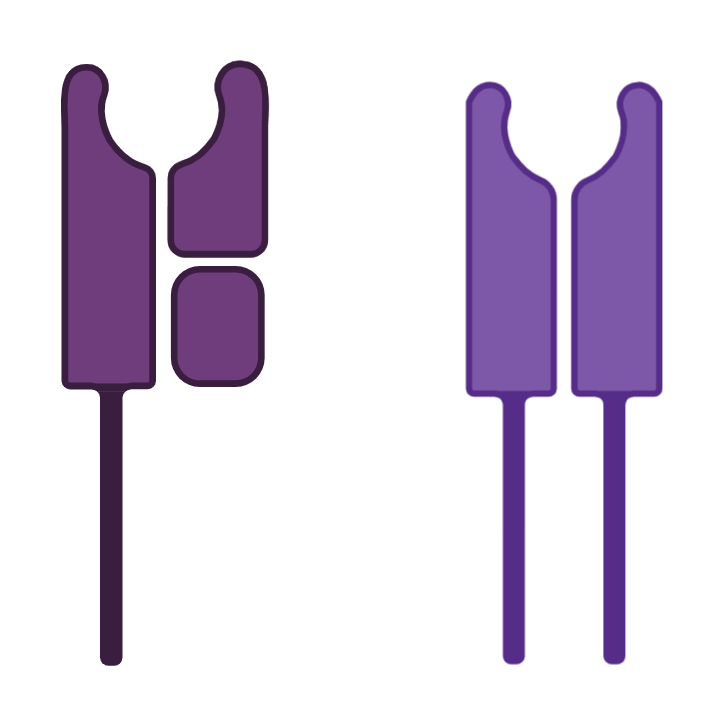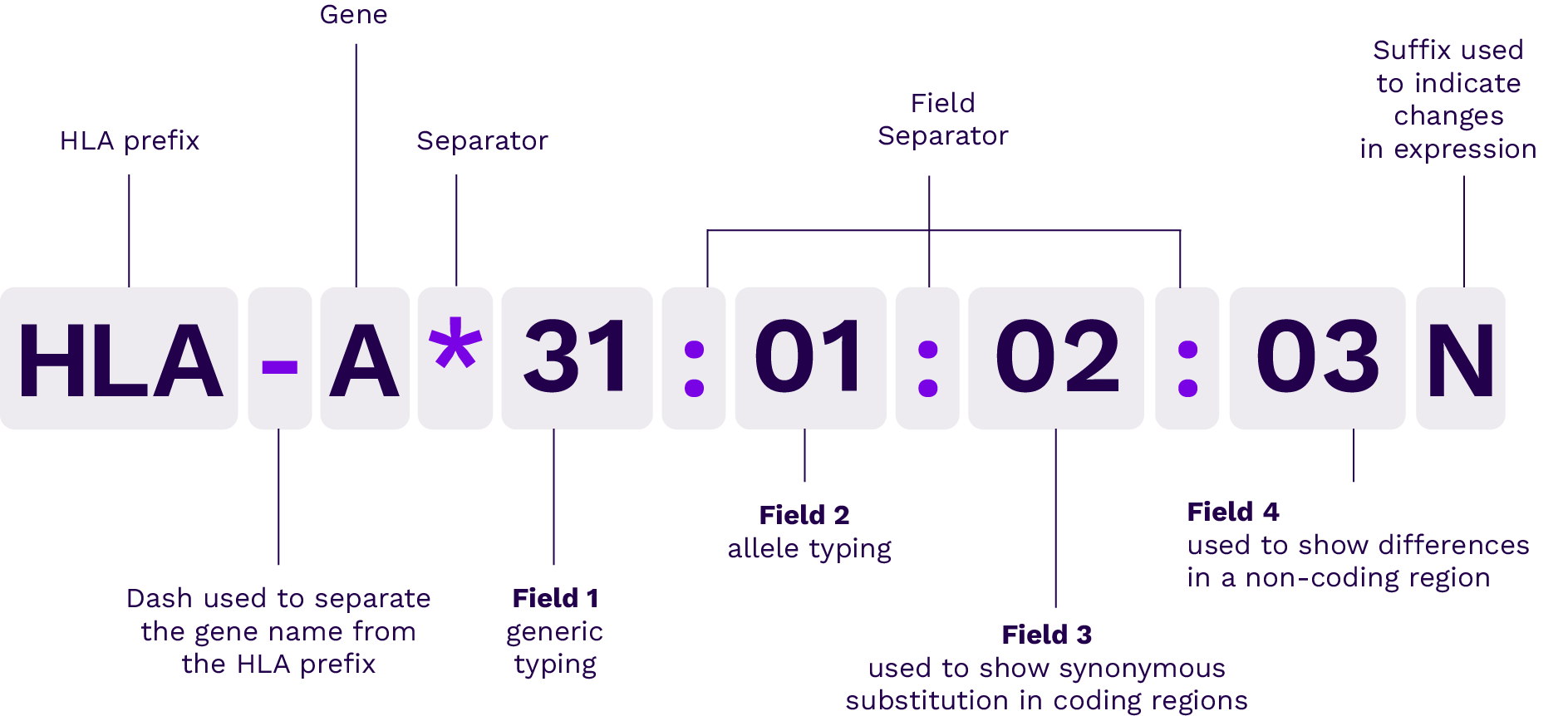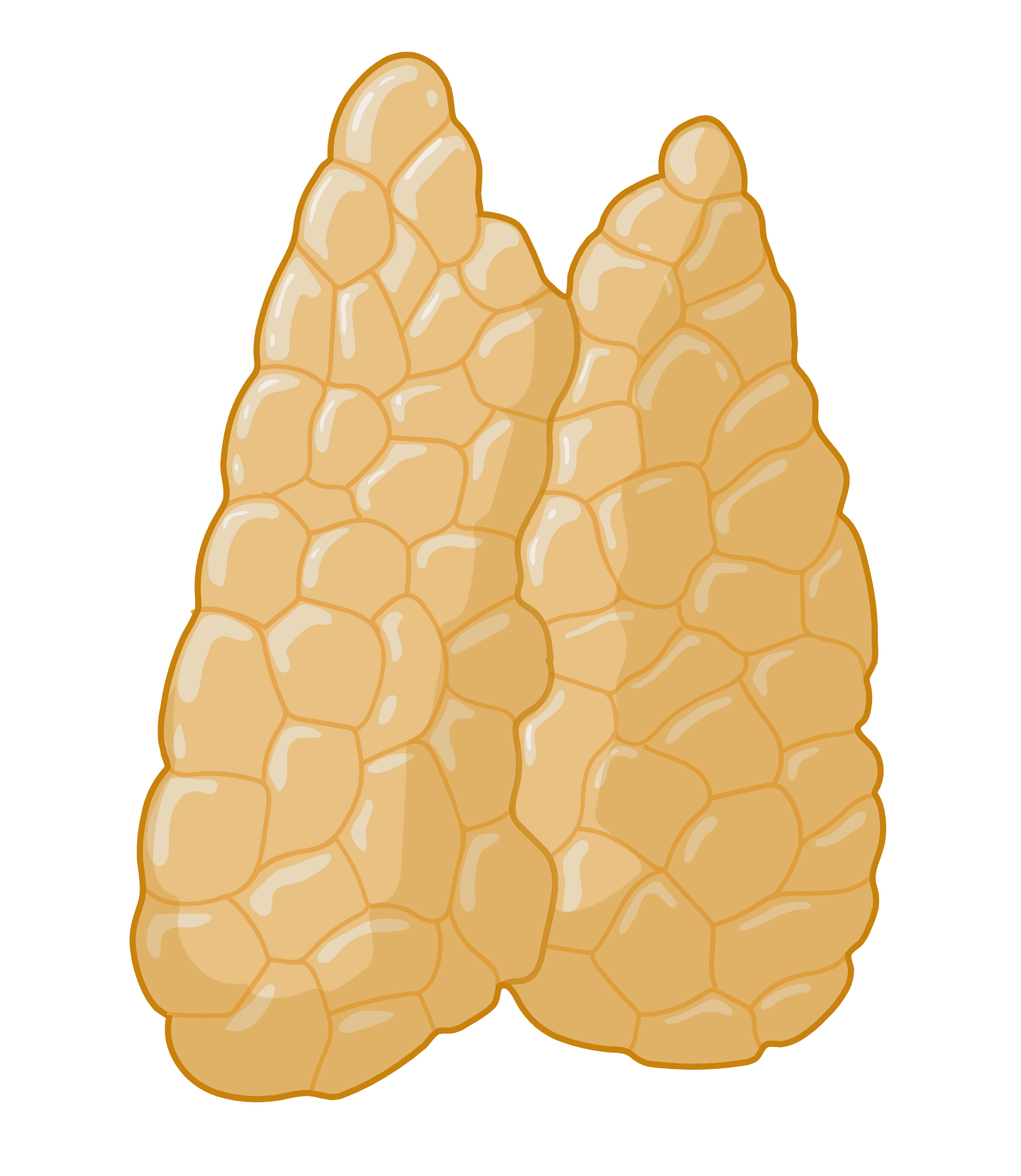
Class I HLA Class II HLA
Classical Class I ad Class II HLA molecules are key molecular actors in the initiation of adaptive immunity, both cellular and humoral, because they ensure antigen presentation to CD4+ and CD8+ T cells, the mechanism responsible for initiating alloreactivity.
Molecular structure
Class I HLA molecules
Class I HLA genes encode an α glycoprotein chain that associates non-covalently with a non-polymorphic chain called β2-microglobulin (β2m) to form a heterodimer, the Class I HLA molecule.
The α chain is formed by a cytoplasmic domain, a transmembrane domain, and three extracellular domains:

- Two very polymorphic domains (α1 and α2), whose association forms a groove where a peptide of 8 to 11 amino acids can be accommodated (classically 9 amino acids, i.e. nonamers).
- A less polymorphic domain (α3).
The β2m chain is made up of a single extracellular domain whose gene is located on chromosome 15.
Class II HLA molecules
Class II HLA genes encode an α chain and a β chain, which combine in a heterodimer to form an HLA class II molecule.
The α and β chains have a similar structure. Each chain is made up of a cytoplasmic domain , a transmembrane domain, and two extracellular domains, including:

- A very polymorphic domain (α1 and β1).
- A less polymorphic domain (α2 and β2).
The association of the α1 and β1 domains of the two chains forms a groove where a peptide of 12 to 25 amino acids can be accommodated.
We distinguish between classical HLA molecules whose main function is the presentation of peptides to T cells, and non-classical HLA molecules , which have other functions (in the preparation of peptides, presentation of antigens of different types, to different cells, etc.).
| Class I HLA | Class II HLA |
|---|---|
| Classical (HLA Ia) HLA-A HLA-B HLA-C | Classical (HLA IIa) HLA-DR HLA-DQ HLA-DP |
| Non-Classical (HLA Ib) HLA-E HLA-F HLA-G MICA/B | Non-Classical (HLA IIb) HLA-DM HLA-DO |
Non-classical HLA molecules are major actors of the immune system, such as HLA IIb HLA-DM and HLA-DO molecules that play a role in the dismantling of the [Class II CLiP-HLA] complex, thus allowing the loading of antigenic peptides.
Non-classical HLA molecules are not developed here.
Characteristics of the classical HLA system
Antigen presentation
It is the main function of Class I and Class II HLA molecules (see antigen presentation).
Haplotype and block transmission
The genetic proximity between the classical Class I and Class II HLA gene loci explains the low probability of recombination occurring in the context of crossing-over in this region. The transmission of alleles therefore occurs in a “block”, which defines a haplotype.

Genes coding for classical Class I and Class II HLA molecules, but also genes for non-classical HLA molecules, as well as more than 100 genes coding for major factors of immunity (e.g., cytokines or complement molecules) are located on the short arm of chromosome 6, and are most often transmitted in haplotype due to their genetic proximity. Each child inherits a maternal and paternal haplotype.
Each individual therefore has 2 copies (one paternal and one maternal) of each HLA molecule: 2 HLA-A molecules, 2 HLA-B molecules, 2 HLA-C molecules, 2 HLA-DRB1 molecules (and 2 HLA-DRA molecules), 2 HLA-DQB1 molecules (and 2 HLA-DQA1 molecules), 2 HLA-DPB1 molecules (and 2 DPA1 molecules).
The genes encoding the α chains of Class II HLA molecules (HLA-DRA, -DQA1 and -DPA1) being less polymorphic than the β chain genes, their polymorphism is often neglected when comparing the HLA typing of two individuals.
Polymorphism
The genes encoding classical Class I and Class II HLA molecules are the most polymorphic in the human species. Alleles encode proteins that differ by one or more amino acids compared to other alleles, but the number of different proteins is fewer than alleles due to redundancy in the genetic code.
Codominance
In addition to very high protein diversity and transmission by haplotype, phenotypic polymorphism is major, because most individuals are heterozygous, and express on the cell surface the molecules of the haplotype inherited from the father, and the haplotype inherited from the mother.
The polymorphism of HLA genes studied in clinical practice is deliberately reported in approximate numbers because the number of known alleles and proteins is constantly increasing, particularly since the massive sequencing of HLA genes.
See http://hla.alleles.org/nomenclature/stats.html for updated figures.
| Class I HLA | |||
|---|---|---|---|
| Gene | A | B | C |
| Alleles | ≈7,800 | ≈9,200 | ≈7,800 |
| Proteins | ≈4,500 | ≈5,500 | ≈4,400 |
| Class II HLA | |||||||||
|---|---|---|---|---|---|---|---|---|---|
| Gene | DRA | DRB1 | DRB3 | DRB4 | DRB5 | DQA1 | DQB1 | DPA1 | DPB1 |
| Alleles | ≈45 | ≈3,500 | ≈460 | ≈230 | ≈190 | ≈580 | ≈2,400 | ≈550 | ≈2,300 |
| Proteins | 5 | ≈2,200 | ≈340 | ≈150 | ≈140 | ≈280 | ≈1,500 | ≈260 | ≈1,300 |
Expression of HLA molecules
The expression of classical HLA genes depends on the cell type, and is influenced by the cellular environment, and in particular pro-inflammatory cytokines .
Class I HLA molecules are expressed by all nucleated cells as well as platelets. A higher density is observed on lymphocytes, monocytes/macrophages, dendritic cells.
In the basal state, the expression of Class II HLA molecules is low and limited to professional antigen-presenting cells : dendritic cells, macrophage, B cells. When these cells are activated, the density of expression of Class II HLA molecules increases. Class II HLA molecules are also found on thymic epithelial cells.
In an inflammatory context (as is the case in organ transplantation!), it should be noted that epithelial and endothelial cells can express Class II HLA molecules. On the other hand, the activation of quiescent T cells can induce the expression of Class II HLA molecules.
The HLA nomenclature
- HLA: HLA region
- HLA-A: HLA-A gene
- HLA-A*31: group of alleles that encode HLA molecules corresponding to the A31 antigen
- HLA-A*31:01: a particular HLA-A*31 allele
- HLA-A*31:01:02: an allele that differs from the HLA-A*31:01:01 allele by a synonymous variation.
- HLA-A*31:01:02:03: an allele that differs from the HLA-A*31:01:02:01 allele by a mutation outside the exons.
Sometimes, the name ends with a suffix, and in particular the letters:
- N: refers to a Null allele (the gene product is then not expressed on the surface of the cell)
- G: refers to a group of alleles whose Genomic sequence of exons 2 (and 3 for Class I) is identical
- P: refers to a group of alleles whose Protein sequence of exons 2 (and 3 for Class I) is identical
- L: refers to an allele whose product is poorly expressed (“Low”)
- S: refers to an allele whose product is Secreted
- Q: refers to an allele whose expression is “Questionnable”
What should be remembered
Overall, the classical HLA system is involved in the discrimination of “self” and “non-self” through peptide presentation. Allelic and phenotypic polymorphism leads to the uniqueness of the adaptive immune response, involved both in protection against infectious agents, but also in anti-tumour monitoring, solid organ and haematopoietic stem cell transplantation, and susceptibility to certain autoimmune diseases.| Class I HLA | Class II HLA | ||
|---|---|---|---|
| α chain | Gene Polymorphism | HLA-A, -B, -C (chromosome 6) Very polymorphic α1 and α2 domains | HLA-DRA, -DQA1, -DPA1 (chromosome 6) Polymorphic α1 domain except DRA (practically invariant) |
| β chain | Gene Polymorphism | β2 microglobulin (chromosome 15) Invariant | HLA-DRB1, -DRB3, -DRB4, -DRB5 HLA-DQB1, -DPB1 (chromosome 6) Very polymorphic β1 domain |
| HLA molecules expressed by | In basal state Inflammatory context or cellular activation | All nucleated cells and platelets (not red blood cells) | Professional APCs : dendritic cells, macrophages, B cells. Thymic epithelial cells T cells Epithelial cells Endothelial cells |
| Antigens presented by HLA molecules | Nature of peptides Size of peptides Special case of dendritic cells and cross-presentation | Endogenous “self” or “non-self” 8 to 11 amino acids Transmembranes of the “self” of an exogenous nature (“self” or “non-self”) = Reflection of cellular microenvironment | Transmembranes “self” of exogenous nature “self” or “non-self” = reflection of the extracellular microenvironment 12 to 25 amino acids |
| Interactions with: | T cell TCR T cell co-receptors Other | α1 and α2 domains α3 domain ⇔ CD8 α1 domain ⇔ NK-cells KIR | α1 and β1 domains β2 domain ⇔ CD4 |




